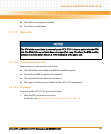
Appendix: A
ATCA-7150 and RTM-ATCA-7150 Getting Started (6806800G42B)
99
ATroubleshooting
A.1 Overview
This chapter describes:
z Precautions
z Principles
z Resources
z LED Display Exceptions
z Power-On Startup Exceptions
z OS Exceptions
A.2 Precautions
A.3 Principles
During troubleshooting, follow the principles:
z Diagnose the outside and then the inside.
In troubleshooting, remove the outside faults, such as power interruption and the faults of
the peer device.
z Diagnose the network and then the NEs (network Elements).
According to the network topology, analyze whether the network environment is normal
and the interconnected device is faulty. Locate the NE to which the fault occurs.
z Diagnose the high speed part and then the low speed part.
From the alarm signal stream, the alarm of the high speed signal often causes the alarm of
the low speed signal. Therefore, remove the fault of the high speed part first.
Before you remove the faults of the ATCA-7150 and RTM-ATCA-7150 suite, be familiar with
the Server System Safety Information shipped with the shelf.


















